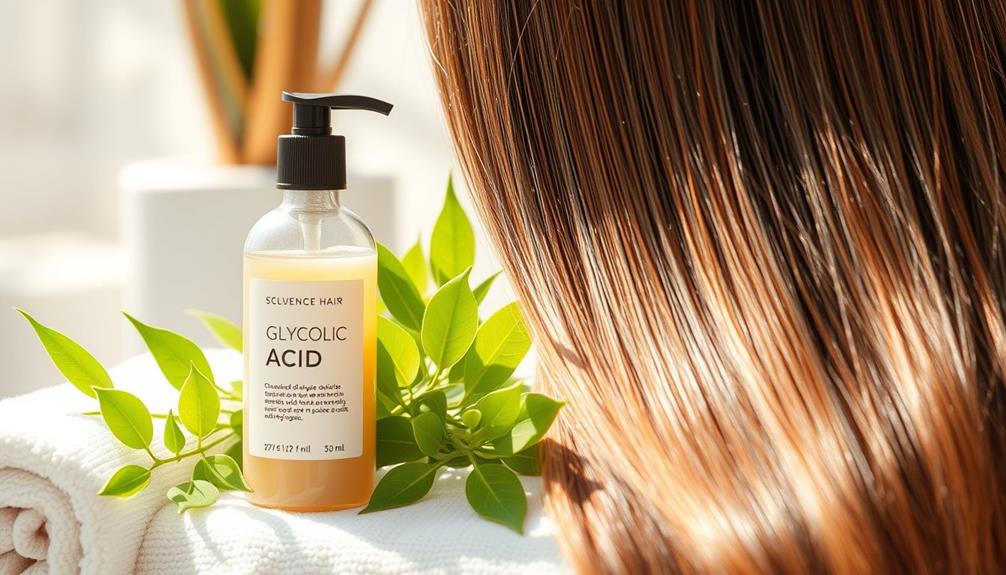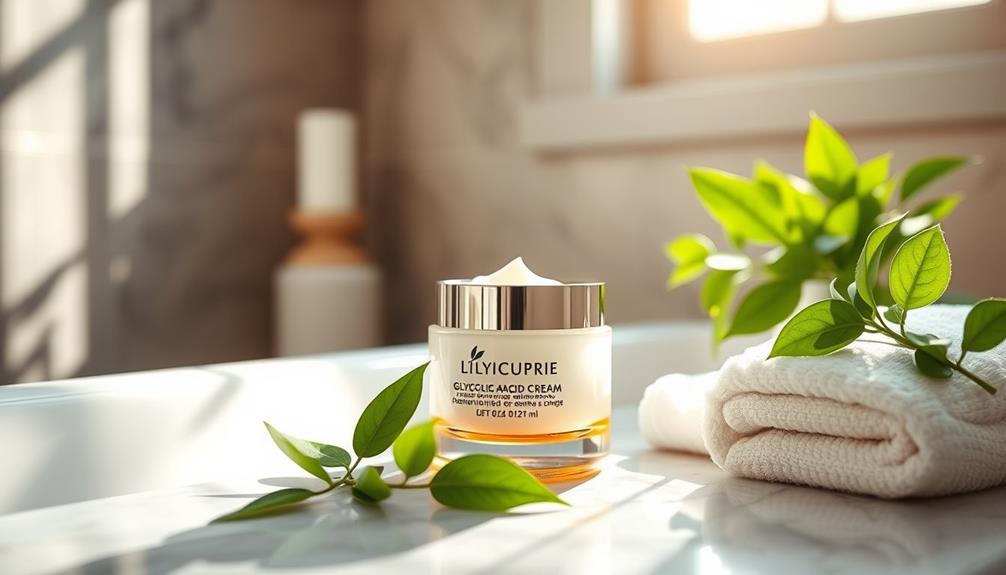Glycolic acid is a powerful alpha-hydroxy acid from sugar cane that works wonders for your skin. It gently exfoliates, helping you achieve a brighter and more even complexion. With benefits like reducing fine lines, treating acne, and enhancing hydration, it's perfect for normal and oily skin types. Start with a low concentration to avoid irritation, and always use sunscreen afterward. If you've got sensitive skin, a patch test is a must. You'll find glycolic acid in various products, from cleansers to professional peels. There's plenty more to discover about how it can fit into your skincare routine! Some additional glycolic acid benefits include stimulating collagen production, which can improve the overall texture and firmness of the skin. It also helps to reduce the appearance of pores and can fade dark spots and hyperpigmentation. Incorporating a glycolic acid product into your skincare routine can help you achieve smoother, healthier-looking skin over time. With consistent use and proper sun protection, you can enjoy the full range of glycolic acid benefits for your skin.
Key Takeaways
- Glycolic acid is an alpha-hydroxy acid that exfoliates and promotes cell turnover, revealing brighter skin.
- It effectively reduces fine lines, uneven skin tone, and acne by unclogging pores and stimulating collagen production.
- Start with a lower concentration (around 5%) and apply in the evening to minimize irritation and sun sensitivity.
- Ideal for normal, combination, or oily skin; patch testing is recommended for sensitive or dry skin types.
What Is Glycolic Acid?

Glycolic acid is an alpha-hydroxy acid derived from sugar cane that penetrates the skin deeply to promote effective exfoliation.
This powerful ingredient breaks down the bonds between dead skin cells, enhancing cell turnover and revealing brighter skin beneath.
You'll find glycolic acid particularly beneficial for addressing skin concerns like uneven skin tone, fine lines, and acne, much like how essential oils can enhance skin health with their therapeutic properties.
Its exfoliating properties help to smooth out skin texture and improve overall appearance.
For at-home use, products typically contain concentrations of 5% to 10% glycolic acid, while professional chemical peels may go up to 70%.
Regular application can boost collagen production, leading to firmer, healthier skin.
However, it's important to be cautious, as glycolic acid can increase sun sensitivity.
Always apply sunscreen during and after treatment to protect your skin from harmful UV rays.
Benefits for Skin

Using glycolic acid can transform your skin by enhancing exfoliation, boosting collagen production, and evening out your complexion.
This powerful acid is known for its exceptional exfoliating properties, effectively removing dead skin cells and promoting cell turnover. As a result, you'll reveal brighter, more radiant skin underneath. Additionally, incorporating essential oils like lavender and chamomile blend can further enhance relaxation and support your skincare routine.
One of the standout benefits of glycolic acid is its ability to stimulate collagen production. This can help improve your skin's firmness and elasticity, reducing the appearance of fine lines and wrinkles.
Additionally, glycolic acid works to even out skin tone and texture by fading dark spots and post-acne discoloration, giving you a more uniform complexion.
If you struggle with acne, glycolic acid can be particularly beneficial. Its antibacterial properties help treat acne by unclogging pores and reducing oil buildup, making it effective against comedonal acne.
Regular use also enhances hydration by attracting moisture to your skin cells, leading to a plumper, more hydrated appearance. With consistent application, you can enjoy smoother, healthier skin that looks and feels revitalized.
Usage Guidelines

To maximize the benefits of glycolic acid while minimizing irritation, it's important to follow specific usage guidelines.
Start with lower concentration glycolic acid products, around 5%, to reduce the risk of skin irritation. As your skin builds tolerance, you can gradually increase the frequency and concentration.
Always apply glycolic acid in the evening. This timing helps decrease sun sensitivity and enhances its effectiveness, as glycolic acid can make your skin more vulnerable to UV damage.
Additionally, maintaining a healthy skin barrier is vital, just as regular vet check-ups are essential for maintaining a cat's health and well-being cat health and nutrition.
Before widespread application, conduct a patch test, especially if you have sensitive skin, to verify you won't react negatively.
It's also essential to incorporate sunscreen daily when using glycolic acid. This protects your treated skin from increased sun exposure and potential hyperpigmentation.
Avoid combining glycolic acid with other strong exfoliants or retinoids to maintain your skin barrier health and prevent excessive irritation.
Following these usage guidelines will help you enjoy the benefits of glycolic acid without compromising your skin's well-being.
Skin Type Suitability

Understanding your skin type is essential for determining whether glycolic acid will be beneficial or potentially irritating for you. Glycolic acid shines for those with normal, combination, or oily skin due to its effective exfoliating properties and oil-reducing benefits. If you fall into these categories, you can likely enjoy improved texture and clarity.
However, if you have dry or sensitive skin, you should proceed with caution. Glycolic acid might cause irritation, especially if you introduce it too quickly. It's important to gradually incorporate it into your routine and monitor how your skin reacts. Seasonal changes can also play a role; winter may heighten sensitivity due to a compromised skin barrier.
Regardless of your skin type, patch testing is a wise step before widespread application. This simple test helps identify any adverse reactions early on.
If you have specific skin concerns, like cystic acne, seeking dermatologist advice is necessary. They can provide personalized recommendations on how to safely incorporate glycolic acid into your skincare regimen. Always prioritize your skin's needs to achieve the best results.
Market Availability

Glycolic acid is easily accessible in a variety of formulations, making it simple for you to find the right product for your skincare needs. You can choose from over-the-counter (OTC) options like cleansers, toners, and serums, or consider professional treatments like chemical peels for more intensive care. The market availability of glycolic acid products caters to different skin types and concerns, including those with hyperpigmentation and acne-prone skin.
Here's a quick comparison of the different glycolic acid options:
| Product Type | Typical Glycolic Acid Concentration |
|---|---|
| Cleansers | 5% – 10% |
| Toners | 5% – 10% |
| Serums | 5% – 10% |
| At-home Chemical Peels | 10% – 30% |
| Professional Treatments | 30% – 70% |
With many popular brands offering glycolic acid products, you'll find options tailored for sensitive skin or specific issues. Plus, online retailers often provide promotions, making these products even more accessible. Whether you're a beginner or a seasoned user, there's a glycolic acid product for you.
Frequently Asked Questions
What Do I Need to Know Before Taking Glycolic Acid?
Before taking glycolic acid, you should start with a low concentration, patch test first, and consult a dermatologist if you have sensitive skin. Don't forget to use sunscreen daily to protect your skin.
What Does Glycolic Acid Do to Your Skin?
Glycolic acid exfoliates your skin, boosts cell turnover, and unclogs pores. It reduces fine lines and dark spots while improving hydration, resulting in a brighter, plumper complexion that looks youthful and revitalized.
How Do You Get the Best Results From Glycolic Acid?
To get the best results from glycolic acid, start with a low concentration, apply it in the evening, and use sunscreen daily. Incorporate it consistently and consider hydrating ingredients to enhance effectiveness and reduce irritation.
What Not to Use With Glycolic Acid?
You shouldn't mix glycolic acid with strong exfoliants, retinoids, or high-concentration vitamin C. Avoid products with alcohol or astringents, and never apply it on broken or sunburned skin to prevent irritation and discomfort.
Conclusion
In the garden of skincare, glycolic acid is like a radiant sun, nurturing your skin's essence.
With its ability to exfoliate and rejuvenate, it helps reveal your true glow.
By understanding its benefits and using it wisely, you cultivate a healthier complexion.
Just like tending to a delicate flower, patience and care will yield beautiful results.
Embrace glycolic acid, and watch your skin blossom into a vibrant masterpiece that reflects your inner beauty.









